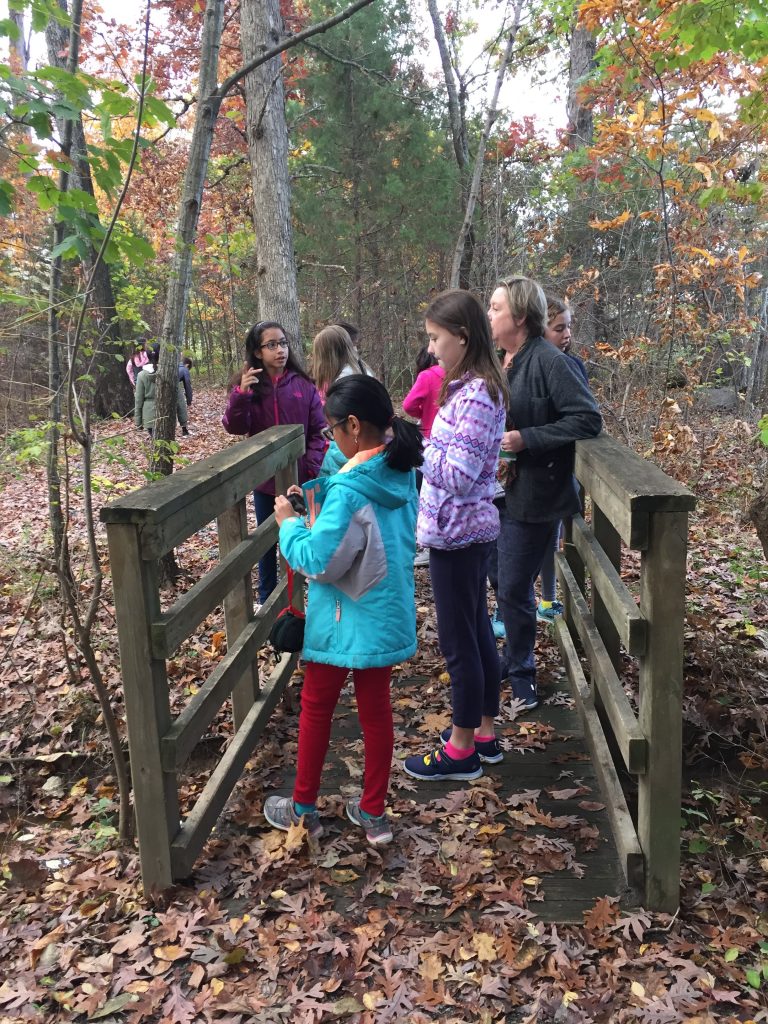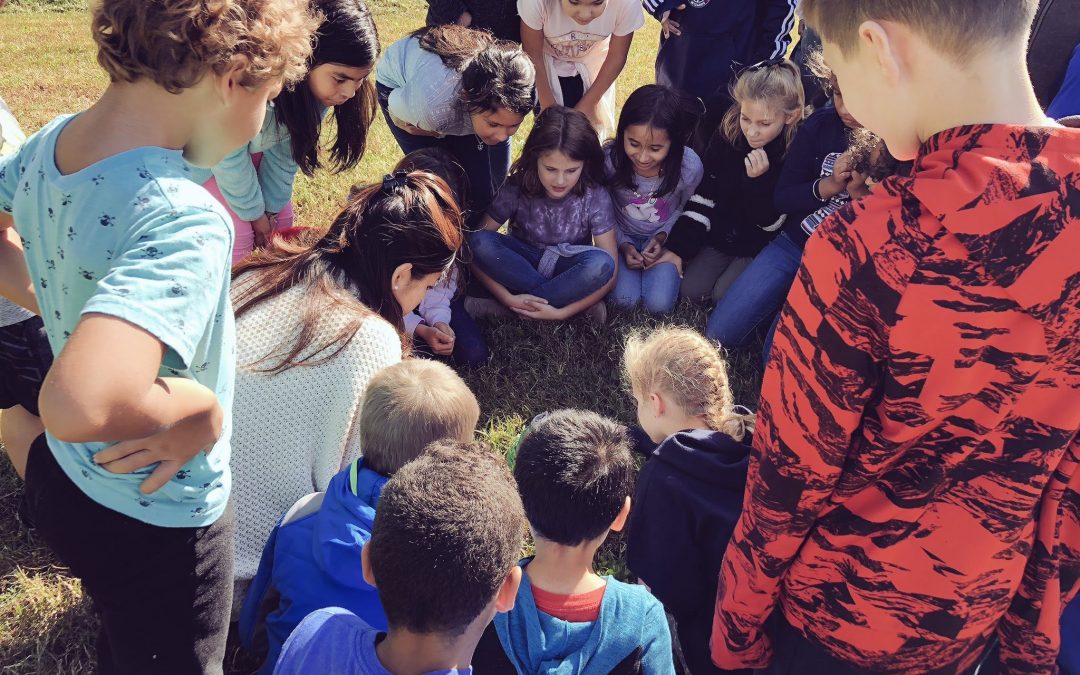By. Josh Douds, Centreville Elementary School
At first sight, Centreville Elementary School (CES), located in Fairfax County, Virginia, is your typical brick and mortar school building. However, upon further inspection one discovers a school filled with innovative teachers and leaders focused on green and sustainability education.
CES is a decorated school when it comes to green initiatives. We were named a 2017 U.S. Department of Education Green Ribbon School for our sustainability efforts. We are currently the only elementary school in the United States to obtain four Eco Flags from the National Wildlife Federation (NWF). CES was also named a Top Ten Green School by the NWF in 2015.
CES’ environmental efforts are led by our Green Team, which is composed of over 100 students in third- through sixth-grade and over 25 staff members. This team meets every Thursday before school starts. We use NWF’s Environmental Pathways as a framework for our actions. Each student team takes on one of the pathways (consumption and waste, water conservation, etc.). Students then create action plans for making changes to our school, based on environmental audits they conduct in the different areas. As part of the NWF-administered Cool School Challenge, CES students conduct energy, water, waste, biodiversity, health, habitats, food, and transportation audits. They create public service announcements and youth-oriented TED-style talks on the environment, work on outdoor education lessons to share with teachers, meet with custodians and cafeteria managers, and work with the administrative team to gather information and get approval for new initiatives.
CES has three outdoor classrooms, a walking trail, and a variety of gardens. We promote healthy eating by partnering with a local farmer to offer organic market days. Third- through sixth-grade students plan and maintain the gardens from planting to harvesting, run the store, order merchandise, take inventory, and use a cash register and a scale.
As principal and instructional leader of the building, my job is two-fold with regard to sustainability. First, I must motivate and educate staff on the benefits of embedding these types of educational practices into their daily instruction. Second, I need to align and focus our established activities toward a common outcome. Throughout our green school journey, we have learned many lessons; explored a plethora of best practices, tools, and resources; and ultimately seen the infinite benefit to our student population.

Although we have many accolades for our green efforts, historically they were achieved by only a small percentage (15 – 20%) of the school population. Our goal is to have 100% of students and staff participating in sustainability learning and green initiatives.
No true growth can occur without time to reflect on road blocks and/or lessons learned. I have learned many lessons through the several road blocks I have encountered during my short time as CES’ leader. All leaders know that a solid vision is needed for success. In my case, the vision I shared with staff included sustainability/green learning. What I did not consider or orchestrate was developing a common understanding and language for this type of learning. My most notable mistake was assuming that this work had been done in the years prior to my arrival. With new staff and leadership, we never had the important conversations around the ‘Why,’ ‘What,’ and ‘How.’ I also learned that there are a variety of views about what sustainability/green learning is and is not. Political views and biases came into play and clouded the overall goal of the initiative. Some staff and community members shared concerns that we were trying to impose our political values on students. From this, I understood that the community needed to have an active presence as we created our common understanding and language. Although these events were frustrating and slowed progress toward our vision, they forced us to reflect, regroup, and redesign our journey.
Based on lessons learned, we have restarted our journey toward embedding sustainability education throughout the school and community. This time our plan is very explicit, methodical, and will be deliberately shared slowly over time. First, we will work as a staff to discover the ‘Why’ and ‘What.’ We will create a common understanding of what educating for sustainability is and what it will look like at CES. Building this foundational understanding for our staff will require resources and tools. Our journey has been and will continue to be supported by the Green Schools National Network (GSNN), U.S. Green Building Council (USGBC), and NWF. Through these organizations’ support and resources, we have set one very specific goal with three short-term objectives to accomplish over a three-year span.
Goal: Embed sustainability learning and activities into daily instruction in all classrooms throughout CES.
Objectives:
- All teachers will take and pass the Green Classroom Professionals Course offered by USGBC.
- A schoolwide Green Hour will be established and included in our master schedule.
- Grade level sponsored Family Field Trips focused on community sustainability efforts will be scheduled.
With these three objectives we hope to educate and inspire our staff, students, and community around environmental efforts. We hope to develop students who possess character traits of independent, problem-solving, environmentally conscious, and future-focused thinkers.

Although we are at the very beginning of our journey, I feel that we have the positive momentum needed to accomplish our goals. It’s amazing how a new outlook on sustainability can change how people view the issue. In October 2018, we held a Sustainability Leadership Summit with staff members who influence our school. I deliberately organized the team to include a variety of viewpoints. Some completely supported our vision, others didn’t really care one way or the other, while others completely disagreed with the idea of green education. During our discussions at the summit, GSNN’s Executive Director Jenny Seydel shared something that resonated with me and helped bring the team together around a common understanding. Jenny said something to the effect of, “Sustainability education is not about saving the planet. Earth has survived through many different catastrophes for millions of years. It is about making life better for our children, grandchildren, and great grandchildren.” This comment resonated with each team member despite their views and helped them see the positive benefits of educating for sustainability. Through our journey, I hope to have similar conversations that allow people to see that this is not a political issue. It’s a way of engaging our students in meaningful learning experiences that will develop them into productive and empowered citizens of the future.
Author Bio
Josh Douds is Principal of Centreville Elementary School, which is part of Virginia’s Fairfax County Public Schools. He has been in education for 20 years and held a variety of positions: general education (3-6), special education (2-6), math resource (K-6), assistant principal, and principal. Josh earned his bachelor’s degrees from Clarion University of Pennsylvania and his master’s degree from George Mason University. He also is an adjunct professor at Fitchburg State University in Massachusetts. There he instructs an online course, Principles for Success for Effective Administrators. Josh believes that sustainability education is not a trend or a fad, but a vehicle to engage students in real-world knowledge and lifelong lessons.

